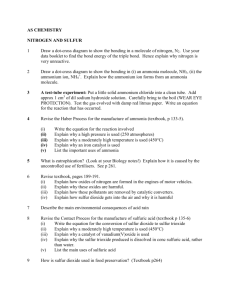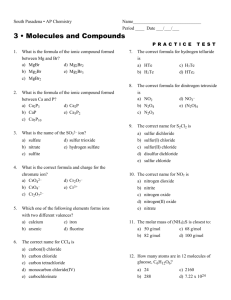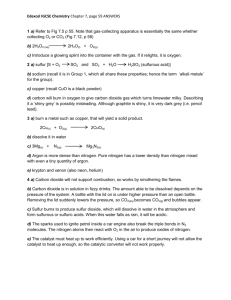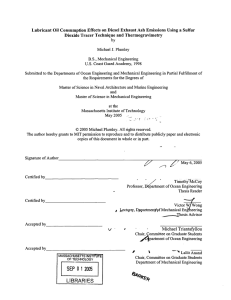Estimation of chemical composition of a solid waste sample
advertisement
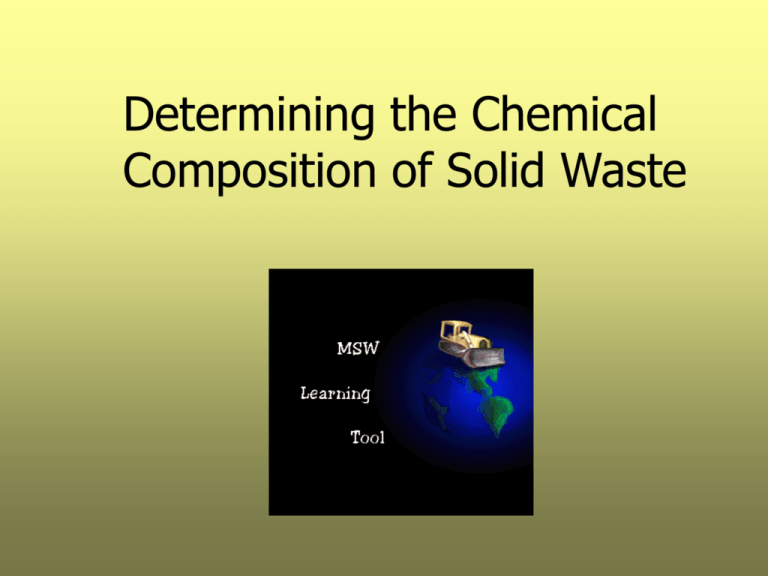
Determining the Chemical Composition of Solid Waste Problem Statement Determine the chemical composition of the organic fraction of the waste described in Table 1, with and without sulfur and with and without water. Table 1. Composition of Solid Waste Component Wet Weight, lbPercent MC Food Wastes 9 70 Paper 34 6 Cardboard 6 5 Plastics 7 1 Textiles 2 10 Rubber 0.5 0 Leather 0.5 20 Yard wastes 18.5 65 Wood 2 20 Inorganic 20.5 3 Step 1: Calculate the Weight of Each Element Using data in Table 2, calculate the weight of C, H, O, N, S, and ash in each component Table 2 is based on dry waste only, first the dry weight of each component must be calculated Results are presented in Table 3 Table 2. Chemical Composition of Waste Components Step 1: Sample Calculation Food Waste MC = 70% 9 - 9(0.7) = 2.7 lb dry weight Carbon: 2.7 (0.48) = 1.3 lb Hydrogen: 2.7 (0.064) = 0.17 lb Table 3. General Composition of Solid Waste Component Food Waste Paper Cardboard Plastic Textiles Rubber Leather Yard Wastes Wood TOTAL Wet Weight Dry Weight lb. lb. 9.0 2.7 34.0 32.0 6.0 5.7 7.0 6.9 2.0 1.8 0.5 0.5 0.5 0.4 18.5 6.5 2.0 1.6 79.5 58.1 C 1.30 13.90 2.51 4.16 0.99 0.39 0.24 3.10 0.79 27.37 Composition H O 0.17 1.02 1.92 14.06 0.34 2.54 0.50 1.58 0.12 0.56 0.05 0.00 0.03 0.05 0.39 2.46 0.10 0.68 3.61 22.95 N 0.07 0.10 0.02 0.00 0.08 0.01 0.04 0.22 0.00 0.54 S 0.01 0.06 0.01 0.00 0.00 0.00 0.00 0.02 0.00 0.11 Ash 0.14 1.92 0.29 0.69 0.05 0.05 0.04 0.29 0.02 3.48 Step 2. Calculate the weight of H and O in water From Table 2 we see that dry waste has a weight of 58.1 pounds, and that asdiscarded-waste has a weight of 79.5 pounds. We then subtract the weight of the dry waste from the weight of the saturated waste to give us the weight of the water in the waste. 79.5 lbs - 58.1 lbs = 21.4 lbs H2O Step 2: Continued We now want to determine how much hydrogen and oxygen in pounds there are in the waste sample. We do this by using the equation: Total _ Moisture _ in _ lb molecular _ wt _ of _ water xmolecularwt _ of _ H Step 2: Continued 21.4lb 18lb * 2 2.38lb _ H Similarly for Oxygen: 21.4lb 18lb *16 19.02lb _ O Step 2: Continued The amount of Hydrogen and Oxygen should be added to the H and O in the waste when we are calculating chemical composition with water. See Table 4. Table 4. Percentage Distribution of the Elements with and without Water Element Carbon Hydrogen Oxygen Nitrogen Sulfur Ash lb, w/o Water* lb, w/ Water 27.37 27.37 3.61 5.99 22.95 42.00 0.54 0.54 0.11 0.11 3.48 3.48 *Row 11, Table 3 Step 4: Determine Molar Composition of the Elements, Neglecting Ash We do this by dividing each component by its respective molecular weight Results in Table 5 Table 5. Molar Composition Element Carbon Hydrogen Oxygen Nitrogen Sulfur Atomic wt 12.01 1.01 16.00 14.01 32.07 Moles Moles W/O Water W/ Water 2.279 2.279 3.575 5.933 1.434 2.625 0.038 0.038 0.003 0.003 Step 5. Determine Chemical Formula Determine the approximate chemical formula with and without sulfur and with and without water To determine the formula without sulfur, use the lowest represented element, nitrogen as the base; divide each value by the number of moles of nitrogen. Similarly, when determining the formula with sulfur use sulfur as a base and divide each by the number of moles of sulfur. See Table 6 Table 6.Normalized Mole Ratios Element Carbon Hydrogen Oxygen Nitrogen Sulfur Mole Ratio - (Nitrogen = 1) Mole Ratio - (Sulfur=1) W/O Water W/ Water W/O Water W/ Water 59.2 59.2 655.8 655.8 92.9 154.1 1028.8 1707.4 37.3 68.2 412.8 755.5 1.0 1.0 11.1 11.1 0.1 0.1 1.0 1.0 Summary of Results The chemical formulas without sulfur are: – Without water: C59H93O37N – With water: C59H154O68N The chemical formulas with sulfur are: – Without water: C656H1029O413N11S – With water: C656H1707O756N11S Note: all values in whole numbers On Your Own Problem Calculate the chemical composition of a typical yard waste with and without water (based on N and S) Hint: Assume 100 lb of waste, 40 % Moisture Content Return to Home Page Last updated July 2004 by Dr. Reinhart


